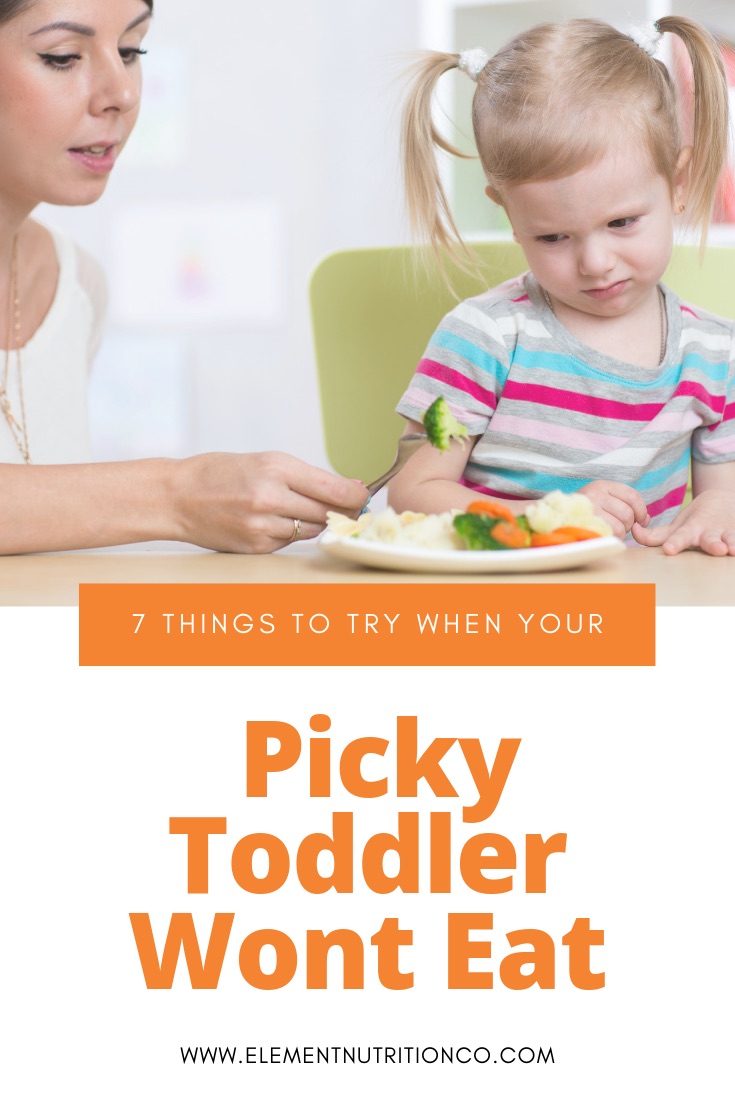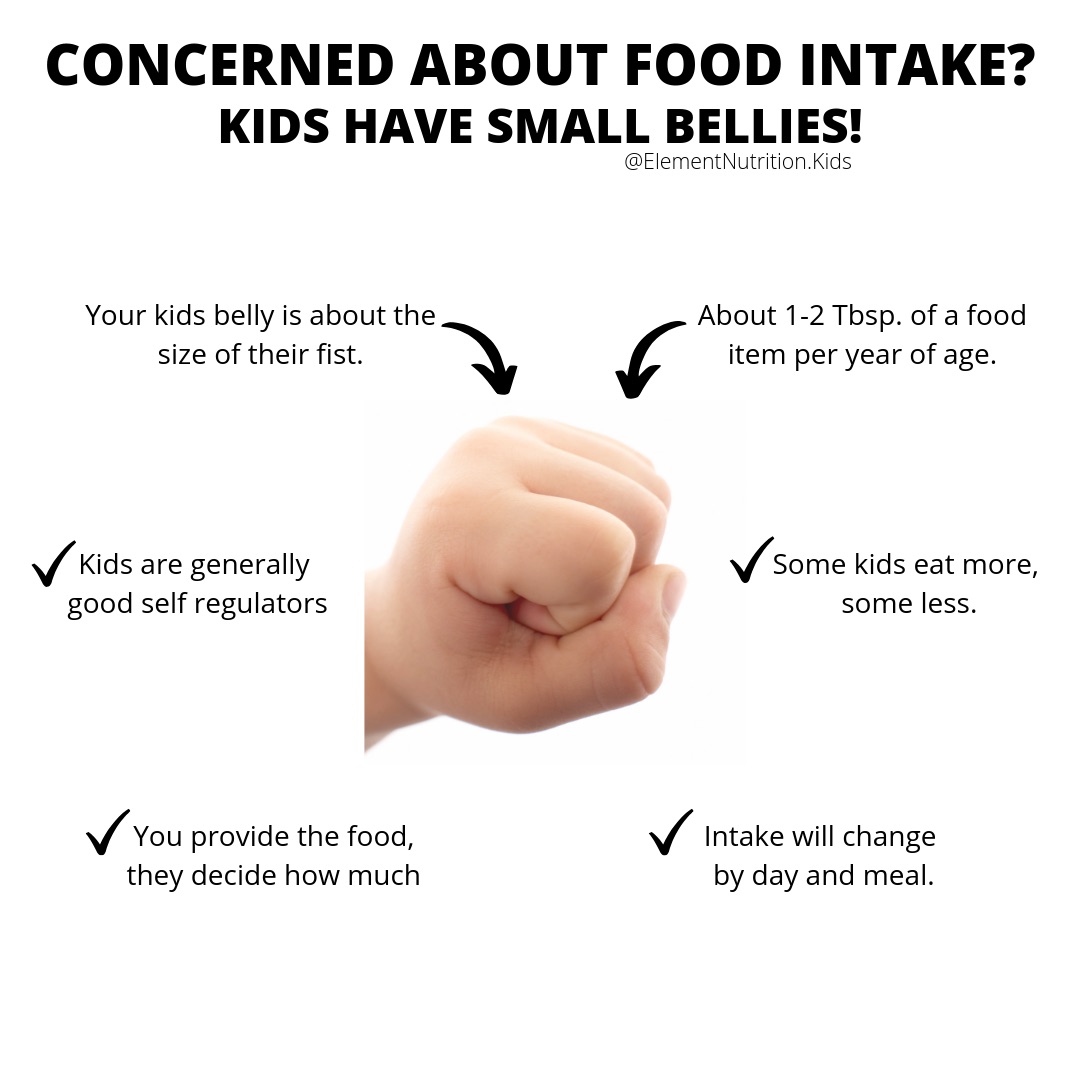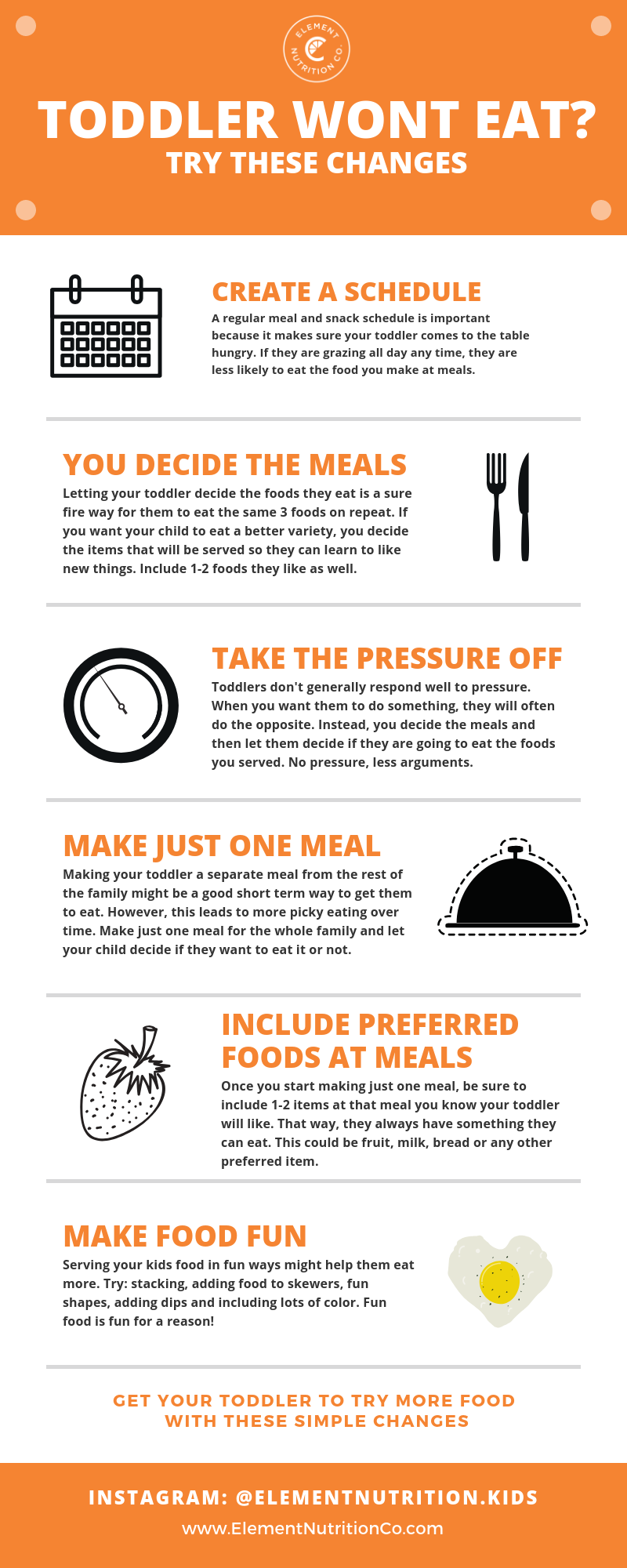A few weeks ago I had a mama in my office who was very stressed about her 3-year-old daughter who “wouldn’t eat anything.” She had been trying everything she could to get her toddler to eat. Sneaking veggies, offering a ton of snacks, and making several dinners each night. If your toddler won’t eat, you probably know how stressful this was for her. Raising a child is hard work and the toddler stage is one of the hardest for many reasons.
Toddlers are natural explorers. They are learning that they have many opinions and they want to express those opinions however they can. Unfortunately for parents, this often comes across as picky eating.
As parents, we are educated on many things to prepare for having a baby. But when it comes to feeding our babies, toddlers, and children, we are often left in the dark. Fortunately, there are a number of strategies you can use when your toddler won’t eat. These strategies will help you get things back on track and make mealtimes less stressful.
Whenever I get a parent in my office with a picky kid, we go through a series of steps to identify the issues and figure out what we can do to turn things around. I’ll be outlining those today.

Table of Contents
Why your toddler won’t eat
There are likely many reasons your toddler won’t eat, but one of the biggest is due to their slowing growth rate. Between the ages of 2 and 4 years (slowly starting at 1 year), your child’s growth is at one of it’s lowest rates. During this time, they gain around 5# per year. This is a huge contrast from their first year when they were growing at rapid speed. Between birth and 12 months, your baby has tripled their weight. Then, the following year, growth starts to gradually slow into the toddler stage.
This period of slowed growth also means a decrease in their appetite. When appetite decreases, they become more selective about what they choose to eat.
The following growth chart shows you the natural curve of a child’s growth velocity. You can see how the curve decreases between 2 and 4 years and then slowly starts to increase again from 4 years on. Generally, picky eating starts to decrease by 6 years of age, but for some, it can last longer.

Toddlers growth and appetite
When your child’s growth slows down, naturally their appetite decreases as well. To help put things into context, let’s use an example we have all faced.
Have you ever gone into a meal when you were not really hungry? It’s usually much harder to make a decision about what you want to eat. When you don’t have a lot of room in your belly, you also tend to pick your favorite items and leave the less appealing options alone.
This is one of the reasons that getting your toddler to the table hungry is important. The number one barrier to this: frequent snacking.
Toddlers have small bellies
When it comes to belly size, I am actually referring to their stomach. If your toddler has a “Buddha” belly, please know that this is normal and will decrease with age. Try to refrain from making comments on your toddler’s belly.
Their stomach, however, is actually quite small. Because of this, frequent snacking, grazing and drinking beverages aside from water (juice and milk) can take up precious room in that small space. This means they come to the table with even less of an appetite.
Your toddler’s belly is about the size of their fist. The timing of meals and snacks is important for ensuring that small space has had time to digest its food and empty before the next mealtime.
The image below will help you better understand why your toddler can’t eat a lot at one time. You can help your toddler eat more by having a good meal and snack schedule in place.

How to get your toddler to eat more
Once you understand and accept that your toddler has slower growth and appetite than when they were a baby, you can start making some simple changes. The best way to help if your toddler won’t eat is to take a look at their feeding environment.
In addition to slowed growth, there are many environmental factors that contribute to their unwillingness to try new things and eat the foods you are making.
Your child’s meal environment has a significant impact on their overall feelings of food and mealtimes. When things are calm, routines are in place and they feel understood, they thrive. If they feel stress or pressure around meals, they will often recoil and push back. How do you do this? I will outline my process below.
1. Create a meal and snack schedule
A solid meal and snack schedule will help your child develop an eating routine that allows adequate time for their body to digest food between eating sessions. When your toddler has time to get hungry, they are more likely to eat at the next meal.
For toddlers, having a meal or snack every 2-3 hours is ideal.
Here is a rough outline of what your toddler’s day might look like (depending on their age):
- 7 am (breakfast)
- 9 am (snack)
- 11-11:30 am (lunch)
- 12-12:30 (naptime starts)
- 3 pm (snack)
- 5:30-6 pm (dinner)
- 7-8 pm (bedtime)
Your schedule will look slightly different depending on what time your child wakes, naps and goes to bed. However, you can see the general outline that I have discussed.
This schedule allows for them to eat smaller amounts at a time, but still provides space between eating sessions for them to develop an appetite.
My daughter is currently on this exact schedule noted above and she is 1 1/2 years old. I will keep this schedule fairly consistent until she is no longer napping. If you have a child that is still napping 1 x/day, your schedule will look similar to this. If they are not napping, the 3 pm snack might move up a bit. If bedtime is more than 3 hours after dinner, you may need to consider adding in a before bedtime snack. Try to fit this in 30-60 min before bedtime if possible.
2. You decide the meals and snacks
When your toddler won’t eat, it can be tempting to allow them to lead the way with the foods they want to eat. This can actually make picky eating worse. When you allow your child to decide what foods they eat, they will probably only pick the select few foods they prefer.
Serving only preferred foods to your toddler will make them eat less in the long run and increase picky eating.
Instead, you should try to follow the division of responsibility in feeding (sDOR). You will hear this term often in my blog posts because I consider it one of the foundations of raising a healthy child (as do most pediatric dietitians I know.)
As the parent, you decide the food that is served (what foods), the time of the day (the schedule) and where the food is served (the location-try to be consistent). It is up to your child if they eat the food you served and how much of that food they want to eat.
If you do your job, it is okay to allow your child to do theirs. Even if that means they want seconds of something you served, or if they choose not to eat something at all.
3. Take the pressure off
There is nothing that will drive your toddler to not want to eat more than if they are feeling your pressure. Try not to push, prod, bribe or coax them into taking bites. This almost always backfires. Instead, use your good food parenting skills to allow them to eat or not.
Increased pressure to eat by a parent = a decreased likelihood of trying or eating foods
Keep in mind that all kids respond differently to pressure. You know your child best!
Including regular family meals are one way to take the pressure off your toddler. When everyone is gathered around the table and all eyes are not on your toddler they just might be willing to try more foods. Family meals also allow for good role modeling by others at the table. Remember that their little eyes are always watching.
4. Avoid making multiple meals
Having a picky child often means they don’t want to eat what you made for dinner. I often hear stories from moms who tell me they are exhausted because every night they cook two meals. One for their family and one for their picky toddler.
When your picky toddler doesn’t want the dinner you prepared and you make them a separate meal this becomes the new expectation.
Instead of making two different meals based on your child’s requests or demands try to give them two different options within the meal that they can take ownership of. For example, you can say: “tonight I am cooking a vegetable with dinner, would you like carrots or broccoli.” It’s possible they will say neither, and that is okay too. You presented an option, great job!
This can be one of the hardest habits for moms to break, but once you do it and do it consistently, it will be a game-changer.
5. Serve a preferred food (or two) at each meal
Once you start moving toward a more regular meal schedule and you stop making your toddler a separate meal, it’s important to serve something they will like. You can ensure there will always be something for them to eat by including 1-2 foods they like. This could be bread, a favorite fruit, milk another grain or a combination of those.
Including 1-2 food items, you know your toddler will eat can help increase their comfort level at the meal. This will also help you NOT make a separate meal.
In my house, the comfort foods tend to be a fruit, a bread item or a cup of milk. Those are all items my daughter will routinely eat. I make sure I always follow this rule myself as it keeps mealtimes pleasant and stress-free. I struggle with this one at home too, so please remember, you are not alone!
Remember, the more often you provide the non-preferred foods, the more the comfort level increases. Kids need consistent repeat exposure to foods before they can learn to like them.
Kids may need up to 15-20 exposures to the same food before they are willing to eat it.
6. Try offering “new” items earlier in the day
If you have an apprehensive eater, timing is important! Your child will likely be in a better mood earlier in the day than at dinner time. If you have a toddler that often loses it when you get home from work after a long day, this is not the time to try to encourage them to eat new foods. This doesn’t mean you can’t make new recipes at dinner. Just keep your expectations lower.
Your child may be most likely to try new foods at the time of day they are in the best mood.
Almost every day when I pick my toddler up from her grandparent’s house she immediately starts fussing. They always tell me “wow she has been an angel all day until you showed up.” I try and keep my expectations in check from 5 pm until 7:30 pm when she goes to bed. It is very normal for toddlers to lose it when their mom or dad comes around. You are the people they are most comfortable around. This will likely get better over time.
7. Make food more fun
Some kids are more visual eaters than others. This means they might be more likely to eat something if they like the way it looks. Consider getting yourself some inexpensive cookie cutters to make trying new things more exciting.
Using novel cutouts, shapes, different sizes, fun picks (safe for age) and other “fun” items will make eating more exciting.
I got this super cute lunch box set from Amazon and have started using it here and there. It comes with small cutouts for things like fruit, bread, cheese, veggies, etc. It also comes with larger cutouts for sandwiches. It even has some super cute small animal and “eyeball” picks that you can stick into food. We haven’t started using the small picks yet, my daughter is only 1 1/2 and is still putting things into her mouth. These are great for older toddlers and pre-schoolers though!
In Conclusion
There are many things to consider when your toddler won’t eat. Try your best to stay calm and not let it interfere with how you act toward your toddler at mealtimes. Create a schedule and be consistent. Keep in mind that picky eating is part of toddlerhood and is affected both by their behaviors/development AND their slowed growth. How you respond to your child in this phase can determine how long and how strong their picky eating gets.



We have always had a picky eater and have done really well with if he doesn’t want to eat that is his choice. Then he is always really hungry in the morning and has a really great breakfast. He has been constipated and his GI doctor has him on laxatives to help him have more regular bowel movements. Now that his bowel movements are normalized to after dinner but now he wakes up in the middle of the night starving. Is it okay to give him a snack, or is this creating a bad habit.
Hi Kaylan,
I would try and start by ensuring there is at least 1 thing at dinner he is comfortable eating. That could be fruit or milk or bread or part of the main dish. That way you know there is an opportunity to eat. For bedtime snacks, I usually will do it by the clock more than based on how they eat at dinner. Generally, I like to see around a 2-hour gap between dinner and bedtime to have a bedtime snack. So if you want to make bed snack a routine and bedtime is at 8 pm then I would try and have dinner done by 5:30-6 pm. If bedtime is later than adjust accordingly. Be sure bedtime snack is something nutritious though. If you make it be something super desirable (cookies, crackers etc.) you might see a routine of holding off dinner to get something better at bed snack.
Hi Jessica! I’m trying to implement these steps. However, I’m not having a lot of luck yet. What do you do with the food that they don’t eat? Would you serve it again that day? Or just try something different let’s say for dinner?
I’m also struggling with implementing scheduled snacks. I’ve been so overwhelmed that at the moment I give him snacks when he gets hungry, so changing it to a scheduled one hasn’t settled well with him and he’s asking about snacks more than ever.
Hi Tatiana!
Sometimes the steps can take quite some time. I like to try and keep portion sizes very small to start to prevent food waste, if they do eat it, they can always ask for more. You can re-serve dinner as a pre-bed snack depending on the timing between dinner and bedtime. It really varies by kids and age if a snack is needed. Kids love snacking so will choose to snack all day long if allowed. I find 2-3 snacks per day is sufficient for most kids. Feel free to reach out via my contact form if you would like to work on this together. Sometimes getting a bit more individualized help is the best way to go!